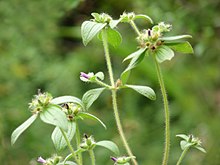

| Melastomataceae
| |
|---|---|

| |
| Pleroma semidecandrum, syn. Tibouchina semidecandra, at Strybing Arboretum, San Francisco | |
| Scientific classification | |
| Kingdom: | Plantae |
| Clade: | Tracheophytes |
| Clade: | Angiosperms |
| Clade: | Eudicots |
| Clade: | Rosids |
| Order: | Myrtales |
| Family: | Melastomataceae Juss.[2] |
| Type genus | |
| Melastoma | |
| Genera | |
|
See text. | |


Melastomataceae (/mɛləstoʊmɑːˈteɪsiˌaɪ, -siːˌiː/) is a family of dicotyledonous flowering plants found mostly in the tropics (two-thirds of the genera are from the New World tropics) comprising c. 175 genera and c. 5115 known species.[3][4] Melastomes are annual or perennial herbs, shrubs, or small trees.
The leaves of melastomes are somewhat distinctive, being opposite, decussate, and usually with 3-7 longitudinal veins arising either from the base of the blade, plinerved (inner veins diverging above base of blade), or pinnately nerved with three or more pairs of primary veins diverging from the mid-vein at successive points above the base.
Flowers are perfect, and borne either singly or in terminal or axillary, paniculate cymes.
A number of melastomes are regarded as invasive species once naturalized in tropical and subtropical environments outside their normal range. Examples are Koster's curse (Clidemia hirta), Pleroma semidecandrum and Miconia calvescens, but many other species are involved.
Under the APG III system of classification, the seven genera from Memecylaceae are now included in this family.[2]
There are some 167 accepted genera in the Melastomataceae family as of October 2023. They are:[5]
Melastomataceae is foraged by many stingless bees, especially by the species Melipona bicolor which gather pollen from this taxon of flowering plant.[7][clarification needed]
| Melastomataceae |
|
|---|---|